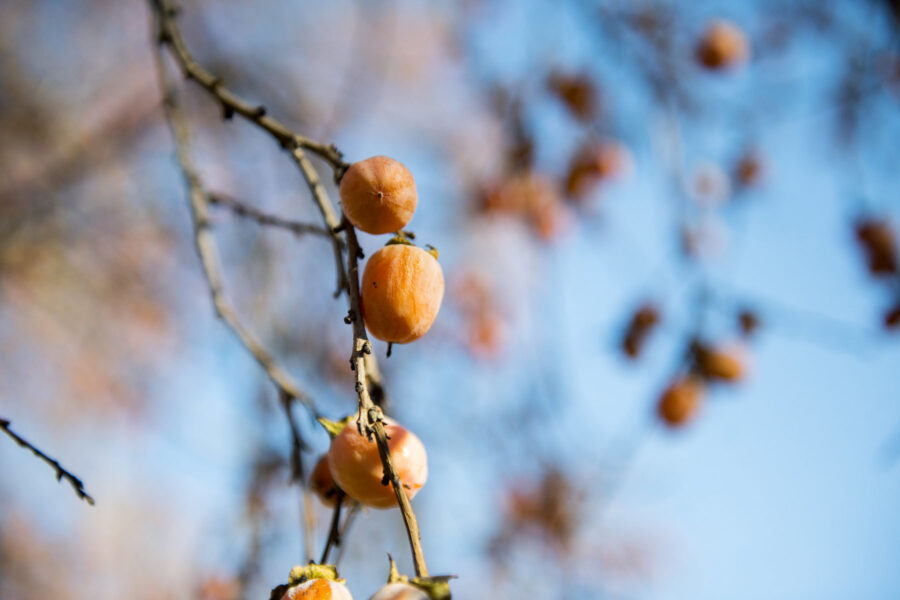The local persimmon is the fall foragers fruit of choice

The American persimmon might not be found at your local grocery store, but they are beloved by woodland foragers. The bright, sweet fruits can be found in forested areas across the watershed are a welcomed sight on gloomy fall days.
For most of the year persimmon trees blend in, producing small white flowers in the spring and plain green leaves in the summer, but this plant shines during fall and winter. It produces one-inch to two-inch bright orange fruits, and after the leaves fall, the tree’s tough grey bark with a pattern reminiscent of reptile scales is revealed.
Persimmon trees can grow to be 60 feet tall but they rarely reach that size. They are a pioneer species that will readily appear in disturbed areas. As the field transitions into a forest, the persimmons are overtaken by larger trees. They are generally found near forest edges.
Dining on American persimmons
Persimmons at any stage can taste like candy, but it’s like the difference between a warhead and a caramel. Unripe persimmons are so astringent they will make your mouth pucker but once ripe they are delicious and sweet. Many people say you shouldn’t harvest persimmons until after the first frost but that isn’t necessary, as long as the fruit is soft and easily pulled from the tree it should be ripe. Another sure sign is if it is wrinkled and deep in color.
The American persimmon has always been prized by American Indians for its many uses. As Europeans later learned, the fruit can be eaten fresh, dried or used for a wide variety of food products including jam, syrup, pies and breads. It was even used to make beer, wine and cider. During the Civil War, the seeds were boiled, roasted and ground to serve as a coffee substitute when trade routes were cut off.
Never had a persimmon? Try some recipes!
Native vs. non-native
In the 1800’s, the Japanese persimmon was introduced to North America and became the favored variety. The fruits are larger and the unripe fruit, although not sweet, lack the unpleasant qualities of the unripe American persimmon. Some nurseries will use the rootstock of American persimmons to graft Japanese persimmons. Using the rootstock of a plant that evolved to thrive here increases the hardiness of the Japanese persimmons.
Since the late 1800’s, plant breeders have been working to make the American persimmon more attractive to home gardeners and farmers by increasing the fruit size, reducing the astringency and creating a fruit that will ship better. If you buy a tree at a nursery, it is most likely one of the varieties breeders have worked on.
Looking to add persimmons to your yard?
If you’re interested in adding a persimmon to your yard you will need to check to see if your local nursery carries the plant. A nursery that specializes in native plants might be your best option if you want the American persimmon, as most nurseries carry Asian persimmon varieties. Be aware that many trees won’t produce fruit for several years after planting and both a male and female tree are needed to produce fruit.
Wildlife value
Humans aren’t the only species that loves persimmons! During the spring, the flowers provide a rich source of nectar for honeybees, bumblebees, little carpenter bees, digger bees, mason bees, leaf-cutting bees and cuckoo bees. More than 45 butterfly and moth species lay their eggs on persimmon trees, including the Luna moth. After the tree fruits it is loved by mammals and birds. Raccoons, foxes, black bears, skunks, turkeys, opossums, yellow-rumped warblers, cedar waxwings, catbirds, American robins, pileated woodpeckers and mockingbirds will all find persimmon trees to eat the fruits. Considering how late in the year the fruits ripen, this becomes an important source of food for wildlife at a time when food becomes scarce.
To learn more about plants that are native to the Chesapeake, check out our field guide.

Comments
We have an older persimmon tree on the fence line of our family farm that produces a small, but delicious (when ripe!) amount each fall. Can I dry the seeds to grow more trees? It’s definitely a native variety.
What is the Latin name for native persimmon?
Thank you!
Your comment has been received. Before it can be published, the comment will be reviewed by our team to ensure it adheres with our rules of engagement.
Back to recent stories